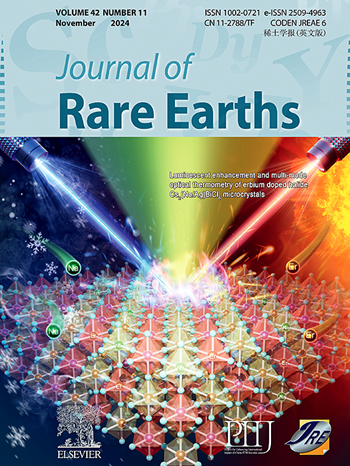基于Eu3+的金属有机框架对生物样品中黄芩苷的灵敏荧光检测
IF 7.2
1区 化学
Q1 CHEMISTRY, APPLIED
引用次数: 0
摘要
黄芩苷是黄芩中发现的主要类黄酮化合物,是首个sars - cov - 23clpro病毒抑制剂。因此,开发一种准确可靠的方法来检测生物系统中的黄芩苷至关重要。本文首次报道了吲哚系镧系金属有机骨架(MOF)材料及其在黄芩苷传感器中的应用。研究结果表明,这种新型晶体结构具有良好的稳定性和发光性能。血清和尿液中黄芩苷的检出限分别为0.05和0.04 μmol/L,具有较高的灵敏度和选择性。实际样品中存在的各种背景物质,如阴离子、阳离子和氨基酸,不会干扰Eu3+的光致发光分析信号。通过粉末x射线衍射分析、傅里叶变换红外光谱、发光寿命、紫外线研究和计算分析,我们确定了Eu-MOF的猝灭是由于黄芩苷、配体和MOF之间的内部过滤效应、吸收能量竞争和光致电子转移引起的。因此,我们设计了一种方便、灵敏、简便的检测方法,并证明了Eu3+基材料是检测实际血清和尿液中黄芩苷的有前途的传感器。此外,所制备的Eu-MOF@polyvinyl乙醇复合基质膜检测膜对于黄芩苷的便携式检测具有相当的实际应用价值。本文章由计算机程序翻译,如有差异,请以英文原文为准。

Sensitive fluorescence detection of baicalin in biological samples using Eu3+-based metal–organic frameworks
Baicalin, a major flavonoid compound found in Scutellariae radix, is the first SARS-CoV-2 3CLpro virus inhibitor. Therefore, developing an accurate and reliable strategy to detect baicalin in biological systems is vital. Herein, we report the first indolyl-lanthanide metal–organic framework (MOF) materials and their application as baicalin sensors. The results of this study indicate that the new crystal structure has good stability and luminous performance. The detection limits of baicalin in serum and urine are 0.05 and 0.04 μmol/L, respectively, suggesting high sensitivity and selectivity. Various background substances present in practical samples, such as anions, cations, and amino acids, do not interfere with the photoluminescence analytical signal of Eu3+. We identified that the quenching of the Eu-MOF is due to the inner filter effect, absorption energy competition, and photoinduced electron transfer among the baicalin, ligand, and MOF through powder X-ray diffraction analysis, Fourier transform infrared spectroscopy, luminescence lifetimes, ultraviolet studies, and computational analysis. Thus, we designed a convenient, sensitive, and facile detection method using the Eu-MOF and demonstrate that Eu3+-based materials are promising sensors for baicalin detection in actual serum and urine. Additionally, the prepared Eu-MOF@polyvinyl alcohol composite matrix membrane test film has considerable practical application value for the portable detection of baicalin.
求助全文
通过发布文献求助,成功后即可免费获取论文全文。
去求助
来源期刊

Journal of Rare Earths
化学-应用化学
CiteScore
8.70
自引率
14.30%
发文量
374
审稿时长
1.7 months
期刊介绍:
The Journal of Rare Earths reports studies on the 17 rare earth elements. It is a unique English-language learned journal that publishes works on various aspects of basic theory and applied science in the field of rare earths (RE). The journal accepts original high-quality original research papers and review articles with inventive content, and complete experimental data. It represents high academic standards and new progress in the RE field. Due to the advantage of abundant RE resources of China, the research on RE develops very actively, and papers on the latest progress in this field emerge every year. It is not only an important resource in which technicians publish and obtain their latest research results on RE, but also an important way of reflecting the updated progress in RE research field.
The Journal of Rare Earths covers all research and application of RE rare earths including spectroscopy, luminescence and phosphors, rare earth catalysis, magnetism and magnetic materials, advanced rare earth materials, RE chemistry & hydrometallurgy, RE metallography & pyrometallurgy, RE new materials, RE solid state physics & solid state chemistry, rare earth applications, RE analysis & test, RE geology & ore dressing, etc.
 求助内容:
求助内容: 应助结果提醒方式:
应助结果提醒方式:


